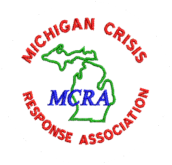

MCRA has developed a Team Registry so that those in need can obtain quality, local crisis response services in a timely manner throughout the state. Please note that
only MCRA/ICISF registered team information will be listed on this registry.
Click HERE for a complete Michigan CISM Team Listing!
Please note the Team Registry is being updated as new information is received. Please be patient with us. If you know of information that needs
to be revised, please contact MCRA at teamreg@mcrainc.net or complete a new team registration form. Teams listed in BLUE have updated their
information for 2026/2027. If your team is NOT listed in BLUE, please fill out the team registration form and submit it to MCRA.

Michigan Crisis Response Association, Inc. - 2023

MCRA has developed a Team Registry so that those in
need can obtain quality, local crisis response services
in a timely manner throughout the state. Please note
that only MCRA/ICISF registered team information will
be listed on this registry.
Click HERE for a complete Michigan
CISM Team Listing!
Please note the Team Registry is being updated
as new information is received. Please be
patient with us. If you know of information
that needs to be revised, please contact MCRA
at teamreg@mcrainc.net or complete a new
team registration form. Teams listed in BLUE
have updated their information for 2026/2027.
If your team is NOT listed in BLUE, please fill out
the team registration form and submit it to
MCRA.






















